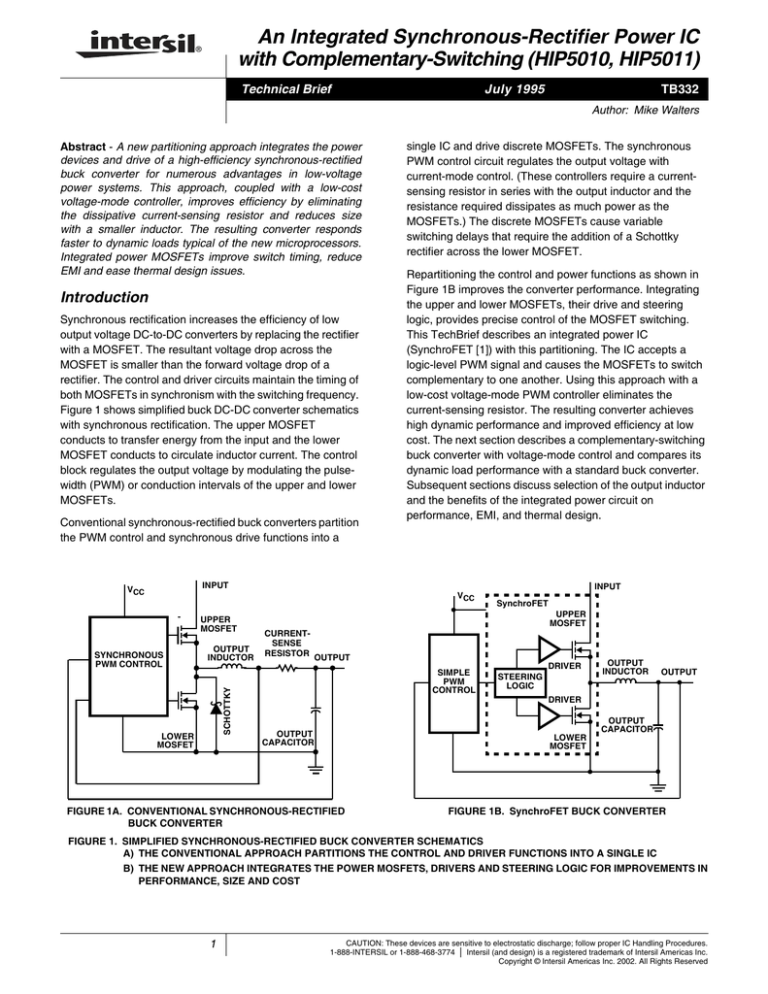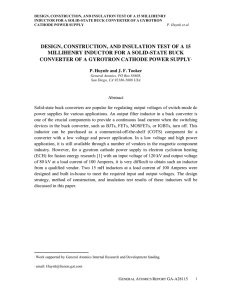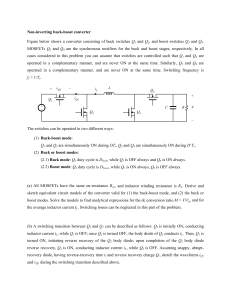
An Integrated Synchronous-Rectifier Power IC
with Complementary-Switching (HIP5010, HIP5011)
®
Technical Brief
July 1995
TB332
Author: Mike Walters
Abstract - A new partitioning approach integrates the power
devices and drive of a high-efficiency synchronous-rectified
buck converter for numerous advantages in low-voltage
power systems. This approach, coupled with a low-cost
voltage-mode controller, improves efficiency by eliminating
the dissipative current-sensing resistor and reduces size
with a smaller inductor. The resulting converter responds
faster to dynamic loads typical of the new microprocessors.
Integrated power MOSFETs improve switch timing, reduce
EMI and ease thermal design issues.
Introduction
Synchronous rectification increases the efficiency of low
output voltage DC-to-DC converters by replacing the rectifier
with a MOSFET. The resultant voltage drop across the
MOSFET is smaller than the forward voltage drop of a
rectifier. The control and driver circuits maintain the timing of
both MOSFETs in synchronism with the switching frequency.
Figure 1 shows simplified buck DC-DC converter schematics
with synchronous rectification. The upper MOSFET
conducts to transfer energy from the input and the lower
MOSFET conducts to circulate inductor current. The control
block regulates the output voltage by modulating the pulsewidth (PWM) or conduction intervals of the upper and lower
MOSFETs.
Conventional synchronous-rectified buck converters partition
the PWM control and synchronous drive functions into a
single IC and drive discrete MOSFETs. The synchronous
PWM control circuit regulates the output voltage with
current-mode control. (These controllers require a currentsensing resistor in series with the output inductor and the
resistance required dissipates as much power as the
MOSFETs.) The discrete MOSFETs cause variable
switching delays that require the addition of a Schottky
rectifier across the lower MOSFET.
Repartitioning the control and power functions as shown in
Figure 1B improves the converter performance. Integrating
the upper and lower MOSFETs, their drive and steering
logic, provides precise control of the MOSFET switching.
This TechBrief describes an integrated power IC
(SynchroFET [1]) with this partitioning. The IC accepts a
logic-level PWM signal and causes the MOSFETs to switch
complementary to one another. Using this approach with a
low-cost voltage-mode PWM controller eliminates the
current-sensing resistor. The resulting converter achieves
high dynamic performance and improved efficiency at low
cost. The next section describes a complementary-switching
buck converter with voltage-mode control and compares its
dynamic load performance with a standard buck converter.
Subsequent sections discuss selection of the output inductor
and the benefits of the integrated power circuit on
performance, EMI, and thermal design.
INPUT
VCC
VCC
SYNCHRONOUS
PWM CONTROL
UPPER
MOSFET
OUTPUT
INDUCTOR
SCHOTTKY
-
LOWER
MOSFET
INPUT
SynchroFET
UPPER
MOSFET
CURRENTSENSE
RESISTOR OUTPUT
SIMPLE
PWM
CONTROL
OUTPUT
CAPACITOR
DRIVER
STEERING
LOGIC
OUTPUT
DRIVER
LOWER
MOSFET
FIGURE 1A. CONVENTIONAL SYNCHRONOUS-RECTIFIED
BUCK CONVERTER
OUTPUT
INDUCTOR
OUTPUT
CAPACITOR
FIGURE 1B. SynchroFET BUCK CONVERTER
FIGURE 1. SIMPLIFIED SYNCHRONOUS-RECTIFIED BUCK CONVERTER SCHEMATICS
A) THE CONVENTIONAL APPROACH PARTITIONS THE CONTROL AND DRIVER FUNCTIONS INTO A SINGLE IC
B) THE NEW APPROACH INTEGRATES THE POWER MOSFETS, DRIVERS AND STEERING LOGIC FOR IMPROVEMENTS IN
PERFORMANCE, SIZE AND COST
1
CAUTION: These devices are sensitive to electrostatic discharge; follow proper IC Handling Procedures.
1-888-INTERSIL or 1-888-468-3774 | Intersil (and design) is a registered trademark of Intersil Americas Inc.
Copyright © Intersil Americas Inc. 2002. All Rights Reserved
Technical Brief 332
Complementary Switching
In a conventional synchronous-rectifier buck converter, the
control circuit and lower MOSFET emulate a rectifier and
cause discontinuous inductor current at light load. For higher
load currents, the inductor current is continuous. The load
current boundary between continuous and discontinuous
conduction is at a load current equal to one-half the peak-topeak ripple current. Complementary switching of the power
MOSFETs maintains continuous inductor current even at
light loads. For load current above the boundary of
continuous and discontinuous current, the behavior of the
converter is the same for both methods.
Figure 2 shows the inductor current for both switching
methods. Figure 2A illustrates the inductor current for a
standard buck converter at light load. The rectifier (or a
synchronous rectifier that emulates a diode) allows current
flow in only one direction. Once the current drops to zero,
the (synchronous) rectifier turns off. The voltage across the
rectifier rings at a high frequency in the parasitic
capacitance. Most converters have a snubber network (a
series connected resistor and capacitor) to suppress this
high frequency noise (EMI) and prevent it from interfering
with other critical circuits.
INDUCTOR
CURRENT
OUTPUT
CURRENT
TIME
FIGURE 2A. STANDARD BUCK CONVERTER
(DISCONTINUOUS CONDUCTION)
(Complementary switching of the power MOSFETs is
analogous to the operation of a Class D power amplifier.)
This property removes one of the disadvantages of voltagemode control for applications with a highly dynamic load.
Voltage-mode control is attractive for low-voltage buck
DC-DC converters due to the simplicity of a single control
loop, good noise immunity and a wide range of PWM duty
ratio [2]. Voltage-mode converters do not require a
dissipative resistor for sensing current (Note 1). However for
a large dynamic load (no-load to full-load), a fast response is
difficult to achieve for the standard buck converter with a
rectifier. This is because the transfer function of
voltage-mode buck converter changes from no-load (with
discontinuous current) to full load. Figure 3 compares the
transfer functions of a standard buck converter at light load
(in discontinuous conduction) with the same converter at
full-load (in continuous conduction). At light load, the power
stage transfer function does not have the double pole (at the
L-C filter frequency) characteristic of the full load transfer
function. Discontinuous (light load) operation removes the
inductor from the converter during a portion of each cycle
and results in the single low-frequency pole as shown in
Figure 3. The designer faces a difficult task of assuring
stability with a single compensation network for both
continuous and discontinuous conduction modes [3].
NOTE:
1. Protection against output overload and short-circuits utilize a
simple output under-voltage detector that initiates a soft-start. In
most power systems, a current limited source supplies the input
of this converter. An overload or short-circuit causes the output
voltage to fall below the under-voltage level and the detector
initiates a soft-start to protect the power system.
20
OUTPUT
CURRENT
TIME
0
GAIN (dB)
INDUCTOR
CURRENT
-20
-40
FULL LOAD
(CONTINUOUS)
LIGHT LOAD
(DISCONTINUOUS)
-60
FIGURE 2B. COMPLEMENTARY-SWITCHING BUCK
CONVERTER (CONTINUOUS CONDUCTION)
FIGURE 2. INDUCTOR CURRENT COMPARISON
A) AT LIGHT LOAD THE INDUCTOR
CURRENT IN A STANDARD BUCK
CONVERTER IS DISCONTINUOUS
B) COMPLEMENTARY SWITCHING THE
SYNCHRONOUS-RECTIFIER MAINTAINS
CONTINUOUS INDUCTOR CURRENT TO
NO-LOAD.
Complementary switching of the power MOSFETs produces
the inductor current shown in Figure 2B. At light load, the
inductor current continues past zero because the lower
MOSFET conducts current in both directions. The upper
MOSFET turns-on with negative inductor current and
transfers instantaneous power from the output to the input.
2
-80
FREQUENCY
FIGURE 3. POWER STAGE TRANSFER FUNCTION. THE
TRANSFER FUNCTION OF THE STANDARD
BUCK POWER STAGE CHANGES FROM LIGHT
LOAD TO FULL LOAD WITH VOLTAGE-MODE
REGULATION
Increasing the value (size and cost) of the output inductor
moves the discontinuous conduction below the minimum
expected load current. This eases the compensation
network design, but the large inductor moves the double
pole to a lower frequency. The large inductor value limits the
rate of current ramp and results in a slow converter response
to a large-signal dynamic. A buck converter with a
Technical Brief 332
complementary-switching synchronous-rectifier operates
with continuous conduction (even at no-load) as shown in
Figure 2B. The inductor selection is not constrained by a
minimum load and discontinuous operation. With this
converter, the output ripple specification and the output
capacitor’s equivalent series resistance (ESR) determine the
minimum output inductor value. A small output inductance
enables a high-bandwidth DC-DC converter for driving fast
dynamic loads (characteristic of modern microprocessors) [4].
phase margin at light load. A practical standard buck
converter requires a larger output inductor and a minimum
load specification. Additionally the compensation network
requires redesign to provide adequate phase margin. Both
increasing the inductance and increasing the phase margin
lowers the bandwidth of the redesigned converter.
Therefore, the complementary-switching buck converter still
responds faster to a large load transient than the practical
standard buck converter with voltage-mode control.
The complementary-switching converter responds much
faster than the standard buck converter (Note 2). Figure 4
illustrates the large-signal dynamic response for each
converter with voltage-mode control. In Figure 4A the
standard buck converter transitions from discontinuous
conduction at the start of the load transient to continuous
conduction. This illustrates the large-signal effect of changing
the power stage transfer function (Figure 3). Figure 4B
illustrates the response of the complementary-switching
converter to a large signal load transient. The inductor current
in the complementary-switching converter reaches 10A in less
than 5μs versus 13μs for the standard buck converter. The
output voltage of the standard buck converter sags to 2.75V
and slowly recovers to its final value. In contrast, the output
voltage of the complementary-switching buck converter falls
to 2.8V and quickly recovers.
Integrated Drive and Power
NOTE:
2. The responses compared here and shown in Figure 4 are the
results of Spice simulations of each converter to large-signal
load transient (No load to 10A in 330ns). Both the standard buck
converter and a complementary-switching buck converter have
identical output filters and compensation components and
operate at 1MHz switching frequency.
Figure 4 illustrates the significance of large-signal operation
on a converter with discontinuous current. However, the
standard buck converter emulated has only a few degrees of
FIGURE 4A. STANDARD BUCK CONVERTER
Integrating the drivers and the power MOSFETs in Figure 1
in a single microcircuit offers several advantages over the
conventional converter with discrete MOSFETs. These
advantages include improved efficiency, higher switching
frequency, lower cost, reduced EMI, and easier thermal
design.
Synchronous rectification with discrete MOSFETs causes
variable switching delays due to the variations in gate
charge and threshold voltage from one MOSFET to another.
Standard control circuits compensate for these variations by
delaying the turn-on drive of the lower MOSFET until after
the gate voltage of the upper MOSFET falls below a
threshold. This prevents overlap in the conduction of upper
and lower MOSFETs and eliminates shoot-through. The
same method is used to delay the turn-on of the upper
device. This causes a dead time where neither MOSFET
conducts and the inductor current flows in the lower
MOSFET’s body diode to store charge on this junction.
Converter efficiency improves with the addition and expense
of a Schottky rectifier to limit stored charge. A typical design
delays the discrete MOSFET conduction with a 60ns dead
time and limits the switching frequency to 300kHz.
FIGURE 4B. COMPLEMENTARY-SWITCHING BUCK
CONVERTER
FIGURE 4. LARGE SIGNAL LOAD TRANSIENT COMPARISON MAINTAINING CONTINUOUS INDUCTOR CURRENT IN THE
COMPLEMENTARY-SWITCHING CONVERTER PROVIDES FAST RESPONSE TO A LOAD TRANSIENT
3
Technical Brief 332
An integrated synchronous-rectifier microcircuit such as
Intersil’s SynchroFET [1], improves efficiency and enables
higher switching frequencies. In contrast to a converter with
discrete MOSFETs, an integrated power circuit design takes
advantage of matched silicon parameters. Worst case
analysis is less severe because similar parameters (such as
gate charge and threshold) tend to track with process
variations and operating conditions. Additionally, the body
diodes of the integrated MOSFETs exhibit low stored charge
and short reverse-recovery times. Integrated power devices
eliminate several bond wires and their parasitic inductance
from the critical high-speed connections. For example, the
SynchroFET minimizes the dead time to under 20ns,
switches with rise and fall times below 10ns, and operates at
frequencies above 1MHz.
The SynchroFET reduces converter cost by eliminating
extraneous components and utilizing a minimum number of
low-cost components. The SynchroFET provides a logic
input compatible with most low-cost PWM Control circuits.
The built-in steering logic does not require a specialized
synchronous-rectifier controller. Configuring the PWM
controller for voltage-mode control eliminates the need for a
current-sensing resistor. Complementary-switching of the
power devices minimizes the output inductance which
further reduces converter costs. Complementary switching
eliminates the high frequency ringing (reduces EMI) at the
inductor terminal and eliminates the need for a snubber
network. The fast switching, the low stored charge of the
body diodes, and the minimal dead time eliminate the need
for an external Schottky diode.
EMI and thermal design issues benefit from integrated
power devices. This is because the substrate (and tab on the
TO-263 package) is at ground potential. This means that
heat can transfer from power devices with a direct
connection to the ground plane. Contrast this with discrete
MOSFETs where the substrate is the drain. Cooling the
discrete MOSFET requires large printed circuit traces on the
drain connection. This is the input trace for the upper
MOSFET and the switching node for the lower MOSFET. A
large trace (for cooling) on the switching node causes
capacitive current that could interfere (EMI) with sensitive
circuits.
Summary
The SynchroFET integrates the upper and lower MOSFETs,
their drivers and the steering logic of a synchronous-rectified
buck converter into a single power IC. The MOSFETs switch
complementarily to maintain continuous inductor conduction.
Using a voltage-mode controller with complementary
switching MOSFETs, results in a small, high-performance,
efficient, and cost effective DC-DC converter. This approach
reduces the converter’s size by minimizing the output
inductance and by minimizing the number of converter
components. Integrated power devices enable more precise
timing control and reduces EMI and thermal design
problems. Complementary-switching improves the
converter’s performance and responds faster to large signal
transients. The SynchroFET with a voltage-mode controller
enhances efficiency by eliminating the current-sensing
resistor. Additionally, this approach reduces cost by
eliminating extraneous components and utilizing low-cost
components. The resulting converter responds faster to
dynamic loads typical of the new microprocessors.
References
For Intersil documents available on the web, see
http://www.intersil.com
[1] HIP5010/5011 (SynchroFET) Data Sheet, Intersil
Corporation, FN4029.
[2] Robert Mammano, “The Pros and Cons of VoltageMode and Current Mode Controllers,” Analog
Applications Issue - Electronic Design, pages 53 & 54,
6/94.
[3] R.P. Severns and G.E. Bloom, “Modern DC-to-DC
Switchmode Power Converter Circuits,” Van Nostrand
Reinhold Company, New York, 1985.
[4] M.T. Zhang, M.M. Jovanovic, F.C. Lee, “Design
Considerations for Low-Voltage On-Board DC/DC
Modules for Next Generations of Data Processing
Circuits”, Conference on Power Electronics and Drive
Systems (PEDS’95), 2/95.
All Intersil U.S. products are manufactured, assembled and tested utilizing ISO9000 quality systems.
Intersil Corporation’s quality certifications can be viewed at www.intersil.com/design/quality
Intersil products are sold by description only. Intersil Corporation reserves the right to make changes in circuit design, software and/or specifications at any time without
notice. Accordingly, the reader is cautioned to verify that data sheets are current before placing orders. Information furnished by Intersil is believed to be accurate and
reliable. However, no responsibility is assumed by Intersil or its subsidiaries for its use; nor for any infringements of patents or other rights of third parties which may result
from its use. No license is granted by implication or otherwise under any patent or patent rights of Intersil or its subsidiaries.
For information regarding Intersil Corporation and its products, see www.intersil.com
4-4



